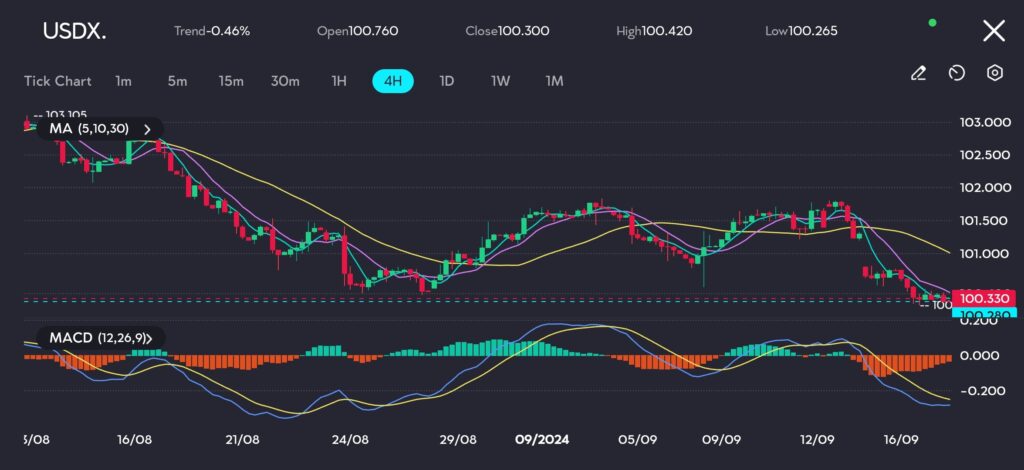Key points:
- The dollar hovers near 2024 lows ahead of the Fed’s rate decision, with a 67% chance of a 50-basis point cut.
- The yen and sterling could rally if the Fed adopts a dovish stance, as contrast with other central banks grows.
The dollar’s value against a basket of major currencies is under pressure, as market participants anticipate the beginning of an easing cycle by the U.S. Federal Reserve.

See: USDX hits lowest point in the year on the VT Markets app.
The U.S. dollar index (DXY) chart is displaying a continued downward trajectory, dipping to its year low near 100.30. After briefly breaking below the 100.51 support level, the dollar has shown little resilience, as bearish momentum dominates.
The 5, 10, and 30-period moving averages are aligned in a bearish configuration, with prices consistently trading below all of them. This indicates persistent selling pressure and a strong downward trend. We see that the MACD histogram is in negative territory, and the signal line is moving below the zero line, confirming that bearish momentum remains intact. Although the histogram is showing some moderation, suggesting a potential slowdown in selling pressure, there is no clear sign of reversal.
We believe that the recent dip reflects market expectations of a more dovish Federal Reserve. Fed funds futures indicate a 67% probability of a 50 basis point rate cut, fueling a bearish outlook for the dollar. Immediate support lies around the 100.30 mark. If this level fails to hold, the next major support level could be seen around 100.00. On the upside, any retracement is likely to face resistance near the 100.75-101.00 region, where the moving averages converge.
With bearish technicals and a dovish Fed outlook, the dollar could remain under pressure. A breach below 100.30 could open the door for further declines, while any potential bounce is likely to face stiff resistance near the 100.75 level.
Euro nears year-high amid dollar weakness
In the early Asian session, the euro (EUR/USD) traded around $1.1123, inching closer to its 2024 high of $1.1201. The Fed’s expected dovish stance is seen as supporting the euro, particularly if the rate cut exceeds expectations. Should the euro break above $1.1201, it could test new resistance levels.
Forecasts suggest that if the Fed pursues a larger-than-expected cut, it may keep downward pressure on the dollar, boosting the euro in the short term. However, any stronger-than-expected U.S. retail sales data could limit the euro’s potential gains.
Yen poised for a rebound
The ninja (USD/JPY) briefly crossed the 140 mark on Monday in thin holiday trade before easing back to 140.77 in Tokyo. It has been the weakest among major currencies this year, giving it more room to rally if the U.S. adopts a dovish policy.
Traders are closely watching for a sustained break below 140, which could open the door for a deeper decline to the January low of 127.215.
Also read: Dollar-yen pair under scrutiny as traders eye central bank moves
A dovish Fed message would create a strong contrast with the Bank of Japan, which is expected to maintain its steady policy on Friday. The BOJ could, however, hint at upcoming rate hikes, potentially leading to more volatility for the yen in the weeks ahead.
Sterling breaks above $1.32 as BOE holds steady
Sterling (GBP/USD) has been the best performer in the G10 currencies this year, rising 3.9% against the dollar. It traded at $1.3203 in the Asia session after breaking the $1.32 level on Monday. The currency’s strength appears to stem from Britain’s forecasted economic data and persistent inflation.
While the Bank of England is largely expected to keep rates on hold at 5% during its Thursday meeting, there’s a 36% chance of another rate cut being priced in by the markets.
Should inflation remain high, the BOE could lean towards further tightening later in the year, potentially pushing sterling even higher against the dollar.
Commodity currencies rally despite China’s troubles
The Australian (AUD/USD) and New Zealand dollars (NZD/USD) rallied early in the week, trading at $0.6746 and $0.6189, respectively, on Tuesday.
Traders appear to be focused on the Fed’s potential dovish pivot rather than weak economic signals from China. These currencies have remained resilient despite concerns about slowing growth in the region.
China’s markets are closed for the Mid-Autumn Festival, but offshore trading of the yuan (USD/CNH) remained stable at 7.0947. Analysts expect the yuan to remain in this range unless new data from China indicates a faster economic recovery.
Eyes on U.S. and Canadian data
All eyes are on the upcoming U.S. retail sales figures, which could give insight into consumer spending trends. A surprise upside could support the dollar and dampen some of the pressure for aggressive rate cuts.
Additionally, Canada’s CPI data due later in the session may offer clues about inflation trends north of the border, potentially impacting the loonie’s performance.
While the markets appear firmly focused on the Fed’s decision, any divergence in the upcoming retail sales data or Canadian inflation trends could immediately shift expectations and affect market volatility in the days to come.







